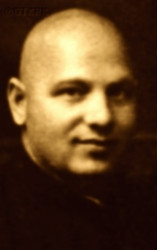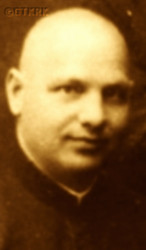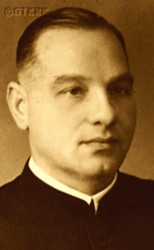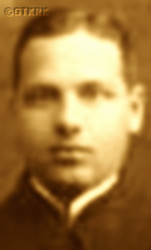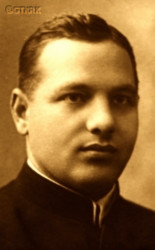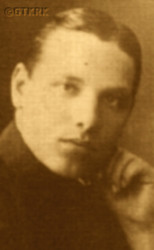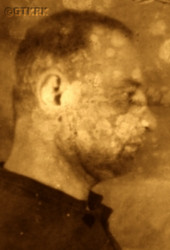Roman Catholic
St Sigismund parish
05-507 Słomczyn
85 Wiślana Str.
Konstancin deanery
Warsaw archdiocese, Poland
full list:
displayClick to display full list

searchClick to search full list by categories
wyświetlKliknij by wyświetlić pełną listę po polsku

szukajKliknij by przeszukać listę wg kategorii po polsku

Martyrology of the clergy — Poland
XX century (1914 – 1989)
personal data
surname
STANKIEWICZ
forename(s)
Adam
function
diocesan priest
creed
Latin (Roman Catholic) Church RCmore on
en.wikipedia.org
[access: 2014.09.21]
diocese / province
Vilnius archdiocesemore on
en.wikipedia.org
[access: 2013.05.19]
Vilnius diocesemore on
en.wikipedia.org
[access: 2013.05.19]
academic distinctions
Sacred Theology Candidate
nationality
Belarusian
date and place
of death
04.12.1949

ITL OzerLagGuLAG slave labour camp network
today: Irkutsk oblast, Russia
more on
en.wikipedia.org
[access: 2020.04.04]
alt. dates and places
of death
29.11.1949
Shevchenkotoday: Tayshet reg., Irkutsk oblast, Russia
more on
ru.wikipedia.org
[access: 2022.01.06]
details of death
In 1938 expelled from Vilnius by Polish authoritites — Mr Louis Bociański, Vilnius Voivode, prob. freemason, supporter of a forced polonization of the Vilnius region — for leading „Belarusian style of pastoral work”.
Returned to Vilnius after German and Russian invasion of Poland in 09.1939 and start of the World War II — after annexation of Vilnius by a third invader of Poland, Lithuanians.
After German defeat in 1944 by the triumphant Russians at the end of the World War II arrested for the first time on 05.12.1944 in Vilnius by the Russians.
However on 08.02.1945 released.
Arrested again by Russians on 13.04.1949.
Held prob. in Lukishes prison in Vilnius.
Accused of „anti–Russian activities, authorship of anti–Russian books and articles and the possession of anti–Russian literature”.
On 31.08.1949 sentenced to 25 years of slave labour in Russian concentration camps — Gulag.
Held in ITL OzerLag concentration camp where — n. Tayshet city — perished in camp's hospital.
To confirm death had chest pierced by a pickaxe by the heart, and head smashed with a wooden hammer.
alt. details of death
Buried on 10.12.1949 on the cemetery n. Shevchenko village, c. 50 km from Tayshet, on Toporok river (tributary of Angara), by the East–Siberian Railway (branch of Trans–Siberian Railway).
cause of death
extermination
perpetrators
Russians
sites and events
ITL OzerLagClick to display the description, OsobLagsClick to display the description, GulagClick to display the description, Vilnius (Lukiškės)Click to display the description, Ribbentrop‐MolotovClick to display the description, Pius XI's encyclicalsClick to display the description
date and place
of birth
06.01.1892

Orlenyatatoday: Kreva ssov., Smarhon dist., Grodno reg., Belarus
more on
be.wikipedia.org
[access: 2023.01.18]
alt. dates and places
of birth
24.12.1891
presbyter (holy orders)
ordination
28.12.1914

positions held
till 1949
priest — Vilniustoday: Vilnius city dist., Vilnius Cou., Lithuania
more on
en.wikipedia.org
[access: 2022.01.06] ⋄ St Therese the Virgin RC church (Gate of Dawn) ⋄ Vilniustoday: Vilnius city dist., Vilnius Cou., Lithuania
more on
en.wikipedia.org
[access: 2022.01.06] RC deanery
1942 – 1943
professor — Vilniustoday: Vilnius city dist., Vilnius Cou., Lithuania
more on
en.wikipedia.org
[access: 2022.01.06] ⋄ Theological Seminary — Lithuanian language
from c. 1939
director — Vilniustoday: Vilnius city dist., Vilnius Cou., Lithuania
more on
en.wikipedia.org
[access: 2022.01.06] ⋄ Belarusian Coeducational Gymnasium
c. 1938 – 1938
chaplain — Slonimtoday: Slonim dist., Grodno reg., Belarus
more on
en.wikipedia.org
[access: 2021.09.29] ⋄ Immaculate Conception Sisters CSIC ⋄ Immaculate Conception of the Blessed Virgin Mary RC church ⋄ St Andrew the Apostle RC parish (main parish)
1929 – 1939
membership — Belarusian Center in Lithuania
1926 – 1936
membership — Vilniustoday: Vilnius city dist., Vilnius Cou., Lithuania
more on
en.wikipedia.org
[access: 2022.01.06] ⋄ Belarusian Institute of Economy and Culture
c. 1934 – c. 1938
prefect — Vilniustoday: Vilnius city dist., Vilnius Cou., Lithuania
more on
en.wikipedia.org
[access: 2022.01.06] ⋄ Holy Spirit RC parish ⋄ Vilniustoday: Vilnius city dist., Vilnius Cou., Lithuania
more on
en.wikipedia.org
[access: 2022.01.06] RC deanery
c. 1932 – c. 1933
prefect — Vilniustoday: Vilnius city dist., Vilnius Cou., Lithuania
more on
en.wikipedia.org
[access: 2022.01.06] ⋄ St Nicholas the Bishop and Confessor RC parish ⋄ Vilniustoday: Vilnius city dist., Vilnius Cou., Lithuania
more on
en.wikipedia.org
[access: 2022.01.06] RC deanery
from c. 1928
resident — Vilniustoday: Vilnius city dist., Vilnius Cou., Lithuania
more on
en.wikipedia.org
[access: 2022.01.06]
1922 – 1927
parliamentary deputy — Seym i.e. Parliament (1st Term), Second Polish Republic
publisher — magazine, „Belarusian Krynica” — also: founder
1922 – 1928
president — Belarusian Christian Democracy (political party) — co‐founder
1921 – 1938
vice president — Belarusian Scientific Committee
1919 – 1936
membership — Belarusian Scientific Society
till c. 1922
resident — Vilniustoday: Vilnius city dist., Vilnius Cou., Lithuania
more on
en.wikipedia.org
[access: 2022.01.06] ⋄ St Nicholas the Bishop and Confessor RC parish ⋄ Vilniustoday: Vilnius city dist., Vilnius Cou., Lithuania
more on
en.wikipedia.org
[access: 2022.01.06] RC deanery
till c. 1922
prefect — Vilniustoday: Vilnius city dist., Vilnius Cou., Lithuania
more on
en.wikipedia.org
[access: 2022.01.06] ⋄ Belarusian Coeducational Gymnasium
c. 1915 – c. 1918
student — Sankt Petersburgtoday: Saint Petersburg city, Russia
more on
en.wikipedia.org
[access: 2020.07.31] ⋄ canon law, Imperial Roman Catholic Spiritual Academy (1842‐1918) — postgraduate specialised studies crowned with Sacred Theology Candidate's degree
c. 1914
vicar — Borodenichitoday: Teterki ssov., Braslaw dist., Vitebsk reg., Belarus
more on
be.wikipedia.org
[access: 2022.08.05] ⋄ St Joseph Spouse of the Blessed Virgin Mary RC parish ⋄ Dzisnatoday: Myory dist., Vitebsk reg., Belarus
more on
en.wikipedia.org
[access: 2021.09.29] RC deanery
from c. 1914
vicar — Druyatoday: Druya ssov., Braslaw dist., Vitebsk reg., Belarus
more on
en.wikipedia.org
[access: 2021.09.29] ⋄ Holy Trinity RC parish ⋄ Dzisnatoday: Myory dist., Vitebsk reg., Belarus
more on
en.wikipedia.org
[access: 2021.09.29] RC deanery
till 1914
student — Vilniustoday: Vilnius city dist., Vilnius Cou., Lithuania
more on
en.wikipedia.org
[access: 2022.01.06] ⋄ philosophy and theology, Theological Seminary
others related
in death
CIKOTOClick to display biography Andrew, GODLEWSKIClick to display biography Vincent, ZJATYKClick to display biography John
sites and events
descriptions
ITL OzerLag: Russian Rus. Исправи́тельно‐Трудово́й Ла́герь (Eng. Corrective Labor Camp) ITL Rus. Озерный (Eng. Ozerniy) — concentration and slave forced labor camp (within the Gulag complex) — headquartered in the town of Taishet in the Irkutsk Oblast (in 1953‐1954 temporarily in Bratsk, in the same oblast). Founded on 07.12.1948 and until 1954 also functioning as the Rus. Особый лагерь (Eng. Special camp) GULAG No. 7. Prisoners among whom were many Poles slaved at the construction of the Baikal‐Amur railway — initially the Tayshet‐Bratsk section, and then from Bratsk to Ust'‐Kut (distance c. 700 km), at forest clearing and wood processing, and the related maintenance of industrial complexes, and the construction of a hydroelectric power plant , in quarries, in lime production, in agriculture and in the production of consumer goods, etc. At its peak — till the death on 05.03.1953 of Russian socialist leader, Joseph Stalin — c. 37,000 prisoners were held there: e.g. 31,881 (01.01.1950); 33,325 (01.01.1951); 37,093 (01.01.1952), one quarter of them were women; 31,225 (01.01.1953); 36,152 (01.02.1953); 29,347 (01.01.1954). Ceased to exist in 1960. (more on: old.memo.ruClick to attempt to display webpage
[access: 2024.04.08], gulagmuseum.orgClick to attempt to display webpage
[access: 2014.11.14])
OsobLags: Pursuant to Decree No. 416‐159сс dated 21.02.1948 of the Russian government, the Russian criminal organization MVD (successor to the NKVD) issued a Decree No. 00219 of 28.02.1948 establishing a separate network of camps within the Gulag system for a „special group” of political prisoners sentenced under Art. 58 of the Penal Code (referring to „enemies of the people”, i.e. accused of treason, espionage, terrorism, etc.) Initially, the group of camps included the ITL MinLag, ITL GorLag, ITL DubravLag, ITL StepLag and ITL BerLag concentration camps. Later, the following ones were added: ITL RechLag, ITL OzerLag, ITL PeschanŁag, ITL LugLag, ITL Kamyshlag, ITL DalLag, ITL VodorazDelLag. After the death of the Russian socialist leader, Joseph Stalin, in 1953, the three largest revolts in the history of the Gulag took place there: the Norilsk Uprising, the Vorkuta Uprising and the Kengir Uprising. In c. 1954 the camps were converted into standard correctional camps. (more on: en.wikipedia.orgClick to attempt to display webpage
[access: 2024.01.26])
Gulag: The acronym Gulag comes from the Rus. Главное управление исправительно‐трудовых лагерей и колоний (Eng. Main Board of Correctional Labor Camps). The network of Russian concentration camps for slave labor was formally established by the decision of the highest Russian authorities on 27.06.1929. Control was taken over by the OGPU, the predecessor of the genocidal NKVD (from 1934) and the MGB (from 1946). Individual gulags (camps) were often established in remote, sparsely populated areas, where industrial or transport facilities important for the Russian state were built. They were modeled on the first „great construction of communism”, the White Sea‐Baltic Canal (1931‐1932), and Naftali Frenkel, of Jewish origin, is considered the creator of the system of using forced slave labor within the Gulag. He went down in history as the author of the principle „We have to squeeze everything out of the prisoner in the first three months — then nothing is there for us”. He was to be the creator, according to Alexander Solzhenitsyn, of the so‐called „Boiler system”, i.e. the dependence of food rations on working out a certain percentage of the norm. The term ZEK — prisoner — i.e. Rus. заключенный‐каналоармец (Eng. canal soldier) — was coined in the ITL BelBaltLag managed by him, and was adopted to mean a prisoner in Russian slave labor camps. Up to 12 mln prisoners were held in Gulag camps at one time, i.e. c. 5% of Russia's population. In his book „The Gulag Archipelago”, Solzhenitsyn estimated that c. 60 mln people were killed in the Gulag until 1956. Formally dissolved on 20.01.1960. (more on: en.wikipedia.orgClick to attempt to display webpage
[access: 2024.04.08])
Vilnius (Lukiškės): Vilnius prison used both by Russians and Germans. Thousands of Poles were kept there. From 2,000 to 16,000 prisoners were jailed at any time there. In 06.1941, after German invasion, Russians murdered most of the prisoners. (more on: en.wikipedia.orgClick to attempt to display webpage
[access: 2021.07.04])
Ribbentrop‐Molotov: Genocidal Russian‐German alliance pact between Russian leader Joseph Stalin and German leader Adolf Hitler signed on 23.08.1939 in Moscow by respective foreign ministers, Mr. Vyacheslav Molotov for Russia and Joachim von Ribbentrop for Germany. The pact sanctioned and was the direct cause of joint Russian and German invasion of Poland and the outbreak of the World War II in 09.1939. In a political sense, the pact was an attempt to restore the status quo ante before 1914, with one exception, namely the „commercial” exchange of the so‐called „Kingdom of Poland”, which in 1914 was part of the Russian Empire, fore Eastern Galicia (today's western Ukraine), in 1914 belonging to the Austro‐Hungarian Empire. Galicia, including Lviv, was to be taken over by the Russians, the „Kingdom of Poland” — under the name of the General Governorate — Germany. The resultant „war was one of the greatest calamities and dramas of humanity in history, for two atheistic and anti‐Christian ideologies — national and international socialism — rejected God and His fifth Decalogue commandment: Thou shall not kill!” (Abp Stanislav Gądecki, 01.09.2019). The decisions taken — backed up by the betrayal of the formal allies of Poland, France and Germany, which on 12.09.1939, at a joint conference in Abbeville, decided not to provide aid to attacked Poland and not to take military action against Germany (a clear breach of treaty obligations with Poland) — were on 28.09.1939 slightly altered and made more precise when a treaty on „German‐Russian boundaries and friendship” was agreed by the same murderous signatories. One of its findings was establishment of spheres of influence in Central and Eastern Europe and in consequence IV partition of Poland. In one of its secret annexes agreed, that: „the Signatories will not tolerate on its respective territories any Polish propaganda that affects the territory of the other Side. On their respective territories they will suppress all such propaganda and inform each other of the measures taken to accomplish it”. The agreements resulted in a series of meeting between two genocidal organization representing both sides — German Gestapo and Russian NKVD when coordination of efforts to exterminate Polish intelligentsia and Polish leading classes (in Germany called «Intelligenzaktion», in Russia took the form of Katyń massacres) where discussed. Resulted in deaths of hundreds of thousands of Polish intelligentsia, including thousands of priests presented here, and tens of millions of ordinary people,. The results of this Russian‐German pact lasted till 1989 and are still in evidence even today. (more on: en.wikipedia.orgClick to attempt to display webpage
[access: 2015.09.30])
Pius XI's encyclicals: Facing the creation of two totalitarian systems in Europe, which seemed to compete with each other, though there were more similarities than contradictions between them, Pope Pius XI issued in 03.1937 (within 5 days) two encyclicals. In the „Mit brennender Sorge” (Eng. „With Burning Concern”) published on 14.03.1938, condemned the national socialism prevailing in Germany. The Pope wrote: „Whoever, following the old Germanic‐pre‐Christian beliefs, puts various impersonal fate in the place of a personal God, denies the wisdom of God and Providence […], whoever exalts earthly values: race or nation, or state, or state system, representatives of state power or other fundamental values of human society, […] and makes them the highest standard of all values, including religious ones, and idolizes them, this one […] is far from true faith in God and from a worldview corresponding to such faith”. On 19.03.1937, published „Divini Redemptoris” (Eng. „Divine Redeemer”), in which criticized Russian communism, dialectical materialism and the class struggle theory. The Pope wrote: „Communism deprives man of freedom, and therefore the spiritual basis of all life norms. It deprives the human person of all his dignity and any moral support with which he could resist the onslaught of blind passions […] This is the new gospel that Bolshevik and godless communism preaches as a message of salvation and redemption of humanity”… Pius XI demanded that the established human law be subjected to the natural law of God , recommended the implementation of the ideal of a Christian state and society, and called on Catholics to resist. Two years later, National Socialist Germany and Communist Russia came together and started World War II. (more on: www.vatican.vaClick to attempt to display webpage
[access: 2023.05.28], www.vatican.vaClick to attempt to display webpage
[access: 2023.05.28])
sources
personal:
kamunikat.orgClick to attempt to display webpage
[access: 2013.01.06], ipsb.nina.gov.plClick to attempt to display webpage
[access: 2018.09.02], pl.wikipedia.orgClick to attempt to display webpage
[access: 2014.12.20]
bibliographical:
„Lexicon of Polish clergy repressed in USSR in 1939‐1988”, Roman Dzwonkowski, SAC, ed. Science Society KUL, 2003, Lublin
original images:
history-belarus.byClick to attempt to display webpage
[access: 2021.12.19], pl.wikipedia.orgClick to attempt to display webpage
[access: 2018.09.02], belarusianheroes.comClick to attempt to display webpage
[access: 2018.09.02], pl.wikipedia.orgClick to attempt to display webpage
[access: 2018.09.02], pawet.netClick to attempt to display webpage
[access: 2014.12.20], dumki.orgClick to attempt to display webpage
[access: 2018.09.02], www.radabnr.orgClick to attempt to display webpage
[access: 2018.09.02], charter97.orgClick to attempt to display webpage
[access: 2018.09.02], ipn.gov.plClick to attempt to display webpage
[access: 2019.02.02]
LETTER to CUSTODIAN/ADMINISTRATOR
If you have an Email client on your communicator/computer — such as Mozilla Thunderbird, Windows Mail or Microsoft Outlook, described at WikipediaPatrz:
en.wikipedia.org, among others — try the link below, please:
LETTER to CUSTODIAN/ADMINISTRATORClick and try to call your own Email client
If however you do not run such a client or the above link is not active please send an email to the Custodian/Administrator using your account — in your customary email/correspondence engine — at the following address:

giving the following as the subject:
MARTYROLOGY: STANKIEWICZ Adam
To return to the biography press below:
 Click to return to biography
Click to return to biography








